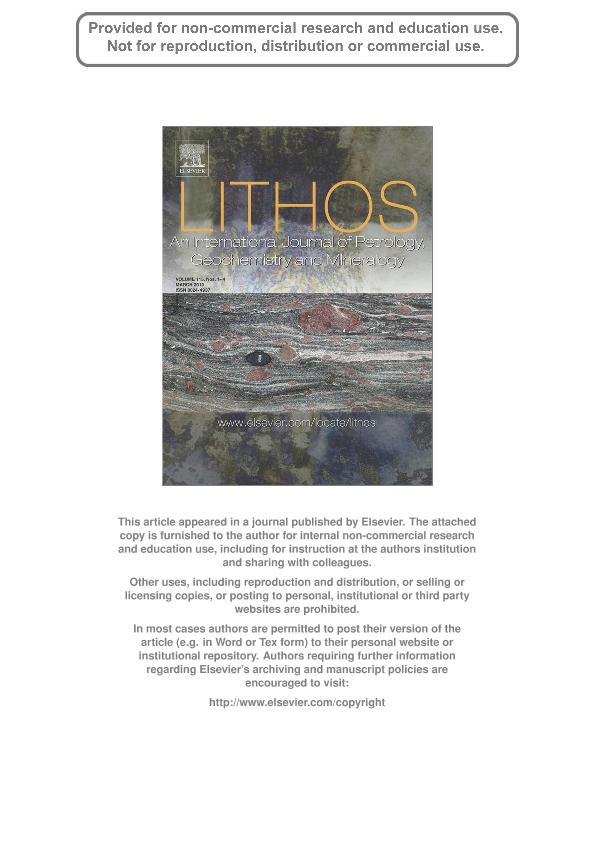Artículo
Fault controlled Carboniferous A-type magmatism in the proto-Andean foreland (Sierras Pampeanas, Argentina): Geochemical constraints and petrogenesis
Fecha de publicación:
03/2010
Editorial:
Elsevier Science
Revista:
Lithos
ISSN:
0024-4937
Idioma:
Inglés
Tipo de recurso:
Artículo publicado
Clasificación temática:
Resumen
The intrusion of granitoids into the Eastern Sierras Pampeanas in the Early Carboniferous took place after a long period of mainly compressional deformation that included the Famatinian (Ordovician) and Achalian (Devonian) orogenies. These granitoids occur as small scattered plutons emplaced in a dominant extensional setting, within older metamorphic and igneous rocks, and many of them are arranged along a reactivated large shear zone. A set of 46 samples from different granitic rocks: Huaco granitic complex, San Blas pluton, and the La Chinchilla stock from the Sierra de Velasco, Zapata granitic complex from Sierra de Zapata, and the Los Árboles pluton from Sierra de Fiambalá, display high and restricted SiO2 contents between 69.2 and 76.4 wt.%. On both FeO/(FeO + MgO) vs. SiO2 and [(Na2O + K2O) - CaO] vs. SiO2 plots the samples plot in the ferroan and alkaline-calcic to calco-alkaline fields (FeO/(FeO + MgO) = 0.88-1.0%;[(Na2O + K2O) - CaO] = 6.3-8.3%), thus showing an A-type granitoid signature. The high concentrations for the High Field Strength Elements (HSFE), such as Y, Nb, Ga, Ta, U, Th, etc. and flat REE patterns showing significant negative Eu anomalies are also typical features of A-type granites. Our petrogenetic model supports progressive fractional crystallization with dominant fractionation of feldspar and a source mineral assemblage enriched in plagioclase. Biotites have distinctive compositions with high FeO/MgO ratios (7.8-61.5), F (360-5610 ppm), and Cl (120-1050 ppm). The FeO/MgO ratios together with the F and Cl content of igneous biotites seem to reflect the nature of their parental host magmas and may be useful in identifying A-type granitoids. The isotopic data (Rb-Sr and Sm-Nd) confirm that the A-type granites represent variable mixtures of asthenospheric mantle and continental crust and different mixtures lead to different subtypes of A-type granite (illustrating the lack of consensus about A-type magma origin). We conclude that prominent shear zones play an important role in providing suitable conduits for ascending asthenospheric material and heat influx in the crust, a hypothesis that is in accord with other recent work on A-type granites. © 2009 Elsevier B.V.
Archivos asociados
Licencia
Identificadores
Colecciones
Articulos(CICTERRA)
Articulos de CENTRO DE INVEST.EN CS.DE LA TIERRA
Articulos de CENTRO DE INVEST.EN CS.DE LA TIERRA
Articulos(CRILAR)
Articulos de CENTRO REGIONAL DE INV. CIENTIFICAS Y TRANSFERENCIA TECNOLOGICA DE ANILLACO
Articulos de CENTRO REGIONAL DE INV. CIENTIFICAS Y TRANSFERENCIA TECNOLOGICA DE ANILLACO
Citación
Dahlquist, Juan Andrés; Alasino, Pablo Horacio; Eby, G. Nelson; Galindo, Carmen; Casquet, César; Fault controlled Carboniferous A-type magmatism in the proto-Andean foreland (Sierras Pampeanas, Argentina): Geochemical constraints and petrogenesis; Elsevier Science; Lithos; 115; 1-4; 3-2010; 65-81
Compartir
Altmétricas




